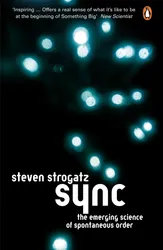I was a little wary of reading a 20 year old book about an emerging science, but I bought it very cheaply in a second hand bookstore, and it’s by Steven Strogatz who wrote Infinite Powers which I enjoyed, so I thought it was worth the risk. I don’t know much about how this field has developed since the book was written so this review is based on my impressions of the book as a layman encountering these ideas for the first time.
This book is about entities that can oscillate between two different states, and how they can spontaneously synchronize together so that they are all either on or off at the same time. The first example, which is revisited throughout the book, is a type of firefly that gathers in one location and in which all the flies flash together. The book considers the rules that each firefly might be following in order to eventually flash in sync with the other fireflies. Other types of oscillators throughout the book include humans clapping, electrical components, neurons in the brain, and chemical reactions. The author makes the case that the same rules are governing systems of oscillators of lots of different types, and that if we can understand these rules it will help us to understand lots of physical phenomena.
The way that systems of oscillators sync up is described in a kind of mathematical language, but there aren’t really any equations in this book. Instead there are some really good charts and diagrams to help with understanding, and some good (and sometimes bizarre) analogies. As well as viewing oscillators as individual entities that follow certain rules in order to sync up, systems of lots of oscillators are considered as a whole. Certain properties of these systems can either make sync inevitable or prevent it from happening, and the changes to these properties over time can cause a sort of ‘phase transition’ (like when a liquid freezes into a solid) so that a system of unsynced oscillators suddenly sync up. The book touches on ideas from thermodynamics, networks and chaos theory to help explain the behaviour of systems of oscillators.
Because real systems of oscillators can be difficult to test experimentally, the scientists in this book often use computer simulations. Although these models simplify the real world, if they exhibit behaviour that matches what we see in real system of oscillators then the scientists can be reasonably sure that they have successfully encoded the rules governing systems of real oscillators. Some other types of oscillators, such as those composed of electrical components, can be experimented on a bit more easily. I was really fascinated by the concept of the Josephson junction, a device consisting of two superconductors connected together. Systems of Josephson junctions can exhibit sync behaviour themselves. But I was also fascinated by the explanation of how superconductivity worked in terms of electrons syncing together, in a similar way to the other oscillators in the book.
The author makes the case for the practical applications of this science. One of these is in medicine, where certain fatal heart problems arise when the cells of the heart go out of sync. So understanding how these states occur and how they could be prevented and corrected could save lives.
Steven Strogatz has worked in this field himself, and has collaborated with some of the scientists mentioned in the book, so there are some personal stories and anecdotes from his work. I particularly liked the description of his work with Art Winfree, and the creative problem solving that took place when they were studying systems of chemical reactions that formed patterns in three dimensions.
With the caveat that reading a 20 year old book about an emerging science might not be the best source of up-to-date information, I really enjoyed this book. I found the concepts really interesting and thought-provoking, and I am very interested to learn about how this field has developed in the years since this book was published.
